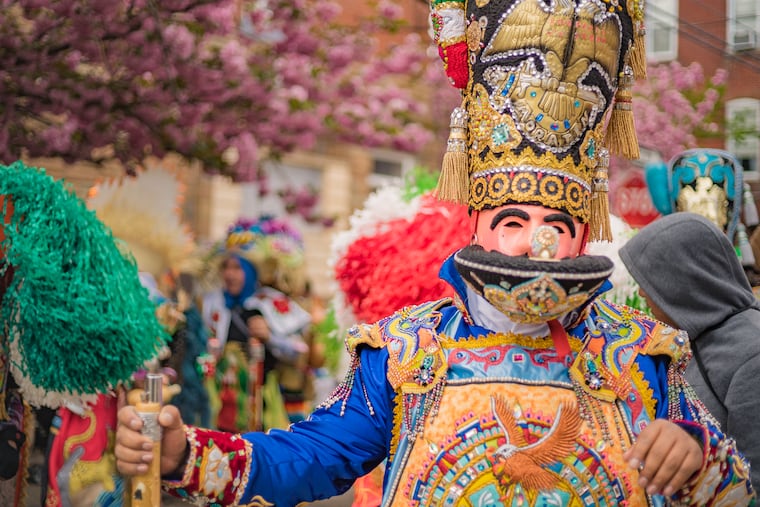El Carnaval de Puebla, a celebration of Mexican culture, returns to Philly this Sunday
Philly's Mexican community celebrates the 18th edition of El Carnaval de Puebla this weekend with a parade, live music, games, and food, and more.

Contrary to popular belief, Cinco de Mayo (May 5) isn’t Mexico’s Independence Day. (That would be September 16.) But, it does mark the 1862 Battle of Puebla when two Mexican battalions (Indios Serranos and Zacapoaxtlas) fought and defeated three French brigades (Zuavos, Turcos, and Zapadores).
To commemorate this victory, a carnival was born in Huejotzingo, Puebla, and a version of it, El Carnaval de Puebla, returns to Philly on Sunday, April 30.
In 2005, Tamalex restaurant owner David Piña and his siblings brought the carnival from their hometown San Mateo Ozolco in Puebla, Mexico, to Philadelphia. A year later, in 2006, six community members, including Piña, created San Mateo Carnavalero, which organizes the carnival every year. (Since then, El Carnaval de Puebla has only stopped in 2017, due to Trump’s immigration policy concerns, and during the pandemic.)
According to San Mateo Carnavalero representative Edgar Ramírez, they try to keep the tradition as similar as possible to the Huejotzingo carnival. But, “not everything can be recreated.”
To celebrate the 18th anniversary of El Carnaval de Puebla, designer Julieta Zavala will parade with a section called “Que chula es Puebla,” with people dressed with designs alluding to the beauty of Puebla. Mexican artist Daniel Kwansi Ramírezis visiting to showcase his art and hand-painted hats with carnival scenes.
In Philadelphia, the handmade attires, dances, and the legend of Agustín Lorenzo — a Mexican Robin Hood figure — feature as part of the parade. There is no choreography, as dancers learn the movements of their battalions since childhood. San Mateo Carnavalero pays the city’s permits to make the carnival possible, through dancers’ donations and community events.
For Piña, a dancer himself, the hard work is worth it. “We are giving back to the local economy.” And, “having the carnival unfold so openly in the city makes our children feel proud of their roots.”
Live music and games kick off at 9 a.m. at Sack’s Playground. The traditional parade is set to leave at 12:30 p.m. from the 2300 block of South Croskey St., toward 22nd and Wolf St., and end in Sack’s Playground.
This year, about 550 people from Philly, New Jersey, New York, Connecticut, Maryland, Virginia, Chicago, and Los Angeles will be part of the ensemble. Many of them are second-generation children participating for the first time in a tradition that’s brought as many as 15,000 spectators to Washington Ave.
There will be food, art, live performances, and a section dedicated to children with activities and piñatas. And, folks can join the dancers during the parade, so long as they wear Mariachi or China Poblana attires. All events are open to the public, don’t require tickets or RSVP, and are free entry.
Whether you are a veteran or a first-timer, here is what to know about El Carnaval de Puebla:
The parade takes place at 12:30 p.m. But you can visit Sack’s Playground, between 9 a.m. to 6 p.m. to check out these Carnaval de Puebla events:
🥁Live music
Six bands will grace the stage: local Mexican banda La Poblanita, La Carcaña and Orquesta Zacatepec from Puebla, and Banda Que Buena, ESC, and La Tumbadora from New York.
El Carnaval de Puebla falls on Mexico’s “Day of the Children.” Between noon to 3 p.m., they will have a festival dedicated to kids. Children can learn traditional dances, play games such as musical chairs, enjoy piñatas, and take pictures with a famous, 4-foot-tall Mexican rag doll named Lele.
🌮Food and art
You won’t be hungry. Tacos de Puebla Delaware, Gallos de Philadelphia, and Cabañas de San Lucas will serve traditional Mexican cuisine, including tacos al pastor and carnitas. And as you walk around, check out the six Mexican and Latino artisan stands around the park.